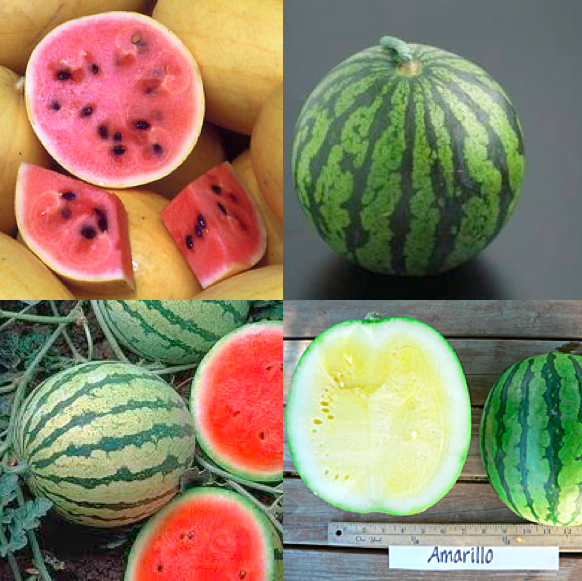When it comes to watermelons, you have a Gulliver’s Travels array of options. Would you like Lilliputian? I have a number of 5 – 10 pound melons I can suggest for you. Something more Brobdingnagian in mind? Step right up for the 200 pound Carolina Cross. There’s something wonderful about a watermelon you can’t lift without friends, but there’s also the reality of balcony weight limits. So how about we steer our attention on over to what are known in the biz as “personal melons”?
First off, can I just say I love the term “personal melon.” It’s like grocers and farmers are trying to convince us that every person at the picnic needs their own five pound watermelon. But the name also gives a nice bit of permission. Let’s say you cut into your personal melon and shortly thereafter all that’s left is some empty rind and watermelon juice all over your chin. You don’t have to hide your guilty, sticky paws. It was a personal melon after all. Permission granted!
Enough about that, let’s get on to choosing your variety. I think one of the most fun things about gardening is being able to get your hands on fruits and vegetables you aren’t going to find at the grocery store. Like that yellow-rinded watermelon up there, top left. It’s a variety called a Golden Midget. Golden midgets aren’t as super sweet as some varieties, but the color is killer. You’re way cooler than the average kid when you roll into the pot luck with that baby. For info on the rest of those melons up there, plus a list of other watermelon options worth considering, click on through.
Let’s get back to those pictures. Top left, as mentioned, is a variety called Golden Midget. Then we’ve got…
- Top right: Sugar Baby. This popular variety turns out melons in the 6-10 pound range, and with a rind on the thin side, you get a lot of juicy goodness in each fruit.
- Bottom left: Tiger Baby. Similar to the Sugar Baby, but look at that gorgeous stripes on the rind. It’s almost worth growing just for decoration.
- Bottom right: Amarillo. I’m a sucker for that yellow. Not only is the Amarillo’s color gorgeous, it’s super sweet. There’s this wonderful measurement cultivators of fruit, wine, and honey use to describe sweetness. It’s called Brix. One degree Brix is equal to one gram of sugar in 100 grams of solution. Anything over 9 Brix is considered very sweet. Amarillo scores a 10.4. That’s serious business.
These varieties are hardly the end of the wonderful watermelon down at the Lilliputian end of the spectrum. I could go on and on, but instead, I’ll just give you a few names to Google on your own. These beauties are worth a gander:
- Cream of Saskatchewan (ever seen a white watermelon?)
- Extazy (you know you love it based on name alone)
- Golden Sunrise (more yellow flesh, but with such a thin, gorgeous rind)
- 7177HQ (sounds like a science experiment, but it’s practically off the charts sweet)
Look them up. You’ll thank me, I promise.

Is it true that seedless varieties aren’t as tasty?
We got an amazing yellow seedless watermelon in our CSA share this week. Sooo good. Judging by that one, I’d say seedless can be pretty fabulous! The seedless ones they usually sell at the grocery store are another matter, but I don’t think those should sour you on the whole world of seedless melons.